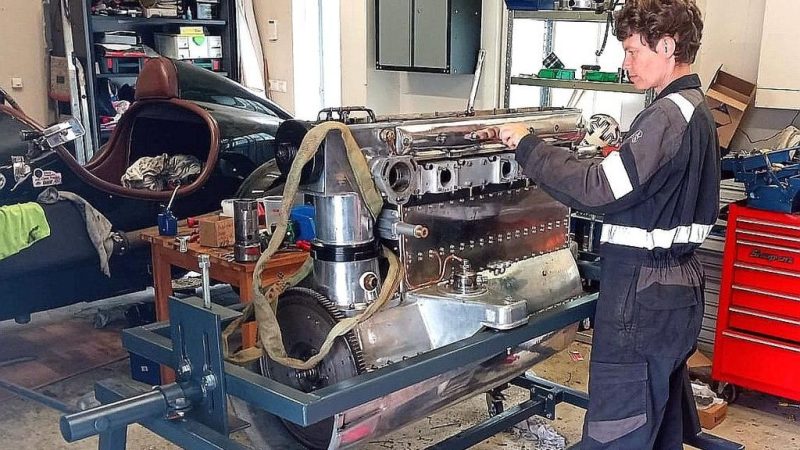Engine stands are great to have on hand for when you need to work on an engine outside a vehicle. However, if your engine is particularly large, you might find off-the-shelf solutions difficult to find. [Liebregts] was recently contacted by someone in just such a pickle, who had an 8-litre Bentley engine from 1928 and nothing to put it on. Thus, constructing a custom engine stand was in order.

The stand is built out of stout 50x50x4mm steel tubing in order to handle the weight of the gigantic vintage engine. It’s designed with an eye to ground clearance, such that an engine crane can easily slide under the stand when it’s time to lift the engine back in the car. It also allows the whole engine to be turned upside down, and even raised and lowered. This makes it easier to get to different parts of the engine, while keeping the center of gravity where it needs to be to avoid the whole assembly falling over.
It’s not a hugely complicated build, but it goes to show just how much of a difference it can make when you have the right tools for the job. With the engine out and on its stand, it’s much easier to work on and handle the many complicated tasks in its restoration. It also benefits from being custom built to suit the dimensions of the Bentley engine. Everything fits and it just works!
While few of us have rare 1928 Bentleys in need of an engine-out service, it’s a build that should serve as great inspiration for those working on similar tasks. Meanwhile, consider building yourself a custom engine crane to help out around the garage.
















1928? Yeah, I don’t have much to do with that modern stuff :-)
I had an almost tragic event happen when a purchased engine stand collapsed as it was moved. The stand was rated for 1000 lbs and I had about 300 lbs on it. When I assembled the stand I was scratching my head at the thin walled metal tubing used, but thought… hey what do I know? When the stand collapsed I was sitting next to it on a mechanics stool and simply moved the stand a bit. Thankfully, and very thankfully the stand collapsed just short of my knee otherwise I would have had a Flamingo joint for a knee. At that point I simply removed the engine block… tore apart the stand and took its pieces to the metal recyclers… and on my way back I bought proper square tubing (2″ with 0.125″ wall) and welded up my own stand. I will never, never, buy products like these if my spidey sense says otherwise.
As someone who sells inexpensive engine stands, among other things, I’d be very interested in knowing where you got the stand or what brand it was. Found out about some defective jack stands a few days before the company got their recall out off of forums before.
I’m sorry, I just do not understand what your last sentence actually means.
I’ve tried saying it and reading it but ” ….. before the company got their recall out off of forums before” just does not make sense to me.
Obviously I’m not fluent enough in the language to decode the subtleties of expression here and I hope you will forgive me for asking you to write it in a different way to help me comprehend. Thanks
“Using information posted on forums I found out about some defective jack stands a few days before the company found out and made their recall notice.”
I guess many users posted about their failed jack stands on forums so Josiah noticed the trend, and as a shop owner it’s polite (probably legally required too) not to sell any products you know are faulty.
I’m happy with my el-cheapo Harborfreight engine lift and stand. But they are by now close to a decade old, so who knows what “innovations” their suppliers might have had in the meantime. And I can relate to this article, though this V8 diesel I’m working on is nowhere near the same weight as that behemoth.
As to building my own stuff, I *love* aluminum profiles. It’s better than building with legos.
Oooh that last bit almost feels like heresy… almost..
Its hard to beat the fun you can have with Lego, and its safe to operate even when you know you shouldn’t touch the 3rd degree burns and limb amputating devices…
I also tend to prefer Steel – as even my really cheap crummy Chinesium MIG can weld it – and welding is often the best solution. For my needs I really need to find the money and time to master TIG and get a pretty good TIG setup, but one (handful of) challenge at a time…
Quality Chinese Engineering. Glad you’re safe.
Spend the money on good tools, you won’t regret it. If failure could in any way injure someone, money is well spent on quality gear.
Use a over head crane, to pull the engine out and lower it onto a rigid rolling square tube stand. Having 4 points touching the floor. Therefore eliminating the risk of tipping over.